brake Peugeot 308 2017 Owner's Manual - RHD (UK, Australia)
[x] Cancel search | Manufacturer: PEUGEOT, Model Year: 2017, Model line: 308, Model: Peugeot 308 2017Pages: 392, PDF Size: 10.13 MB
Page 5 of 392

.
Driving recommendations 146
Starting-switching off the engine
1
48
Manual parking brake
1
54
el
ectric parking brake
1
55
Hill start assist
1
62
5-speed manual gearbox
1
63
6-speed manual gearbox
1
63
Gear ef ficiency indicator
1
64
Automatic gearbox
1
65
Dynamic pack (Driver Sport Pack)
1
69
Stop & Start
1
70
Memorising speeds
1
73
Speed limiter
1
74
Cruise control
1
77
Dynamic cruise control
1
80
Display of inter-vehicle time
1
87
em
ergency collision alert system,
emergency collision braking system
1
90
Blind spot monitoring system
1
95
Parking sensors
1
98
Reversing camera
2
00
Park Assist
2
01
Under-inflation detection
20
9Fuel tank
2 13
Diesel misfuel prevention
2
14
Snow chains
2
16
Very cold climate screen
2
17
to
wing a trailer
2
18
en
ergy economy mode
2
19
Accessories
2
20
Changing a wiper blade
2
22
Fitting roof bars
2
23
Bonnet
2
25
Petrol engine
2
26
Diesel engine
2
27
Checking levels
2
28
Checks
231
AdBlue
® and SCR system
(BlueHDi Diesel) 23 3
Warning triangle (stowing)
2
38
te
mporary puncture repair kit
2
39
Spare wheel
2
46
Changing a bulb
2
52
Changing a fuse
2
62
12 V battery
2
68
to
w i n g
2 7 2
Running out of fuel (Diesel)
2
74Petrol engines
2
75
Petrol weights
2
78
Diesel engines
2
81
Diesel weights
2
85
Dimensions
2
89
Identification markings
2
92
Driving
Practical information
In the event of a breakdownte chnical data
DeNON equipment 2 93
7-inch touch screen
2
95
Peuge
O
t Connect Sound (RD5)
3
59
Audio equipment and telematics
Alphabetical index
Contents
Page 6 of 392

4
exterior
W i p e r s 114 -117
Changing a wiper blade 1 17, 222
Keyless
e
n
try and Starting
remote control
5
6 - 60, 63 - 65
Remote control key
5
0 -55, 65
Starting
1
48-154
ele
ctronic stability control
(
eS
C)
121-123
Snow chains
2
16
ty
re pressures
2
45, 251, 292
Inder-inflation detection
20
9-212
Spare wheel
2
46 -251
-
tools
-
r
emoving / refitting
em
ergency collision braking
1
90-194
Lighting
1
07-113
Daytime running lamps (L
eD
s)
1
10
Headlamp beam adjustment
1
13
Changing bulbs
2
52-256
-
f
ront lamps
- foglamps
- d irection indicator repeaters
Very cold climate screen
2
17
Heated windscreen and washer jets
1
17
el
ectric windows, deactivation
7
0-71
Keyless e
n
try and Starting
5
6 - 60
Doors
5
0 -52, 54
-
ope
ning / closing
-
c
entral locking
-
em
ergency control
Alarm
6
7-69
Fuel tank, misfuel prevention
2
13-215
Panoramic sunroof
1
02
Bicycle carrier, roof bars
2
22-223
Accessories
2
20-221
Boot
61-62
-
ope
ning / closing
-
em
ergency release
te
mporary puncture repair kit
2
39-245
Warning triangle
2
38
Parking sensors
1
98-199
Reversing camera
2
00
to
wbar
1
47, 218
to
wing
272-273
Park Assist
2
01-208
Changing bulbs
2
57-261
-
r
ear lamps
-
3
rd brake lamp
-
n
umber plate lamps
-
foglamp Door mirrors
1
05, 113
Blind spot sensors
1
95 -197
Over view
Page 9 of 392

7
Instruments and controls
Courtesy lamps 103
Interior mood lighting, footwell lighting
1
04
Rear view mirror
1
06
Peuge
O
t Connect SOS,
Peuge
O
t Connect Assistance
1
19 -120
uS
B port /
Auxiliary socket
8
5, 312, 366 / 367
5/6-speed manual gearbox
1
63
ge
ar shift indicator
1
64
Automatic gearbox
16
5 -168
Dynamic function
1
69
Stop & Start
1
70 -172
Hill start assist
1
62
Dashboard fuses
2
62-265 Manual air conditioning
9
3
Manual air conditioning (
to
uch screen)
9
4-95
Dual-zone air conditioning (
to
uch screen)
9
5 -98
Air intake / Air recirculation
9
9
Front demist / defrost
1
00
Rear screen demist / defrost
1
01
Manual parking brake
1
54
el
ectric parking brake
1
55 -161to uch screen 4 0 - 46, 295 -357
Setting the date and time
4
7- 49
Opening the bonnet
2
25
PeugeO t Connect Sound (RD5) 359 -378
.
Over view
Page 12 of 392
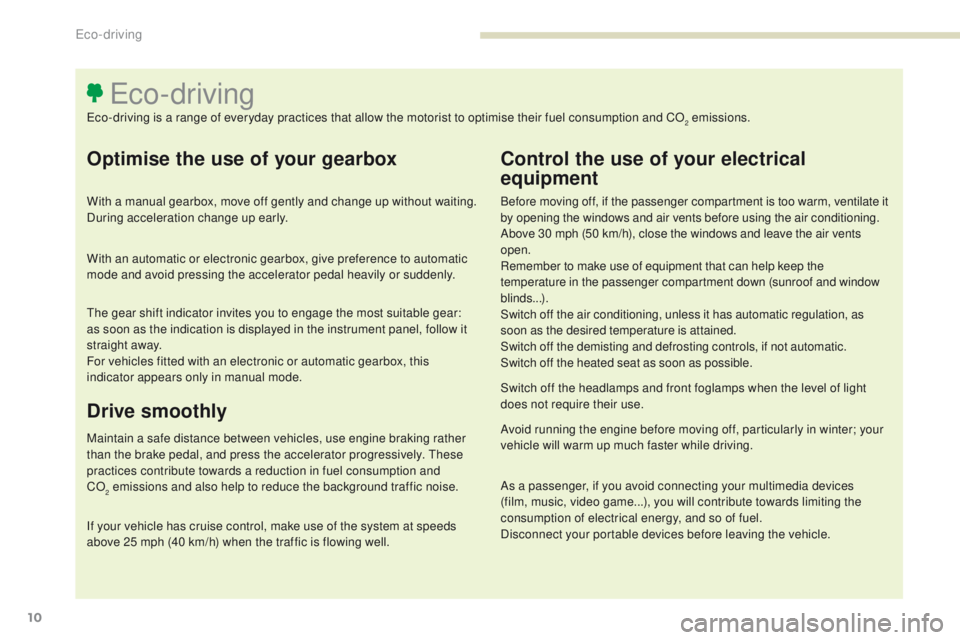
10
Optimise the use of your gearbox
With a manual gearbox, move off gently and change up without waiting.
During acceleration change up early.
With an automatic or electronic gearbox, give preference to automatic
mode and avoid pressing the accelerator pedal heavily or suddenly.
Control the use of your electrical
equipment
Before moving off, if the passenger compartment is too warm, ventilate it
by opening the windows and air vents before using the air conditioning.
Above 30 mph (50 km/h), close the windows and leave the air vents
open.
Remember to make use of equipment that can help keep the
temperature in the passenger compartment down (sunroof and window
blinds...).
Switch off the air conditioning, unless it has automatic regulation, as
soon as the desired temperature is attained.
Switch off the demisting and defrosting controls, if not automatic.
Switch off the heated seat as soon as possible.
Switch off the headlamps and front foglamps when the level of light
does not require their use.
Avoid running the engine before moving off, particularly in winter; your
vehicle will warm up much faster while driving.
As a passenger, if you avoid connecting your multimedia devices
(film, music, video game...), you will contribute towards limiting the
consumption of electrical energy, and so of fuel.
Disconnect your portable devices before leaving the vehicle.
eco-driving
eco-driving is a range of everyday practices that allow the motorist to optimise their fuel consumption and CO2 emissions.
Drive smoothly
Maintain a safe distance between vehicles, use engine braking rather
than the brake pedal, and press the accelerator progressively. th ese
practices contribute towards a reduction in fuel consumption and
CO
2 emissions and also help to reduce the background traffic noise.
I
f your vehicle has cruise control, make use of the system at speeds
above 25 mph (40 km/h) when the traffic is flowing well.
th
e gear shift indicator invites you to engage the most suitable gear:
as soon as the indication is displayed in the instrument panel, follow it
straight away.
For vehicles fitted with an electronic or automatic gearbox, this
indicator appears only in manual mode.
Eco-driving
Page 17 of 392
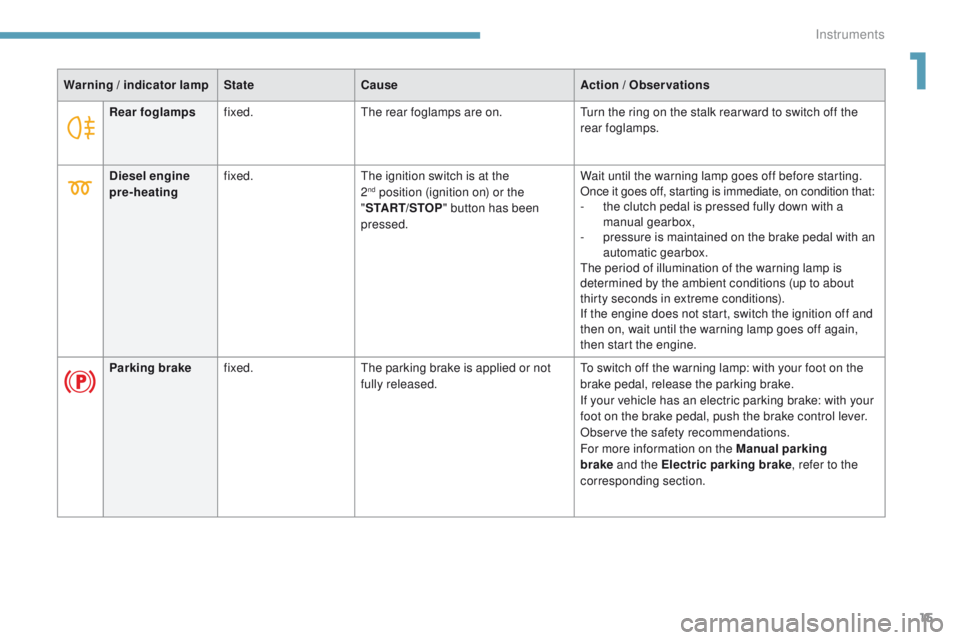
15
Warning / indicator lamp State Cause Action / Observations
Rear foglamps fixed.
th
e rear foglamps are on.
tu
rn the ring on the stalk rear ward to switch off the
rear foglamps.
Diesel engine
pre-heating fixed.
th
e ignition switch is at the
2
nd position (ignition on) or the
" ST
ART/STOP " button has been
pressed. Wait until the warning lamp goes off before starting.
Once it goes off, starting is immediate, on condition that:
-
t he clutch pedal is pressed fully down with a
manual gearbox,
-
p
ressure is maintained on the brake pedal with an
automatic gearbox.
th
e period of illumination of the warning lamp is
determined by the ambient conditions (up to about
thirty seconds in extreme conditions).
If the engine does not start, switch the ignition off and
then on, wait until the warning lamp goes off again,
then start the engine.
Parking brake fixed.
th
e parking brake is applied or not
fully released.
to s
witch off the warning lamp: with your foot on the
brake pedal, release the parking brake.
If your vehicle has an electric parking brake: with your
foot on the brake pedal, push the brake control lever.
Observe the safety recommendations.
For more information on the Manual parking
brake and the Electric parking brake , refer to the
corresponding section.
1
Instruments
Page 22 of 392
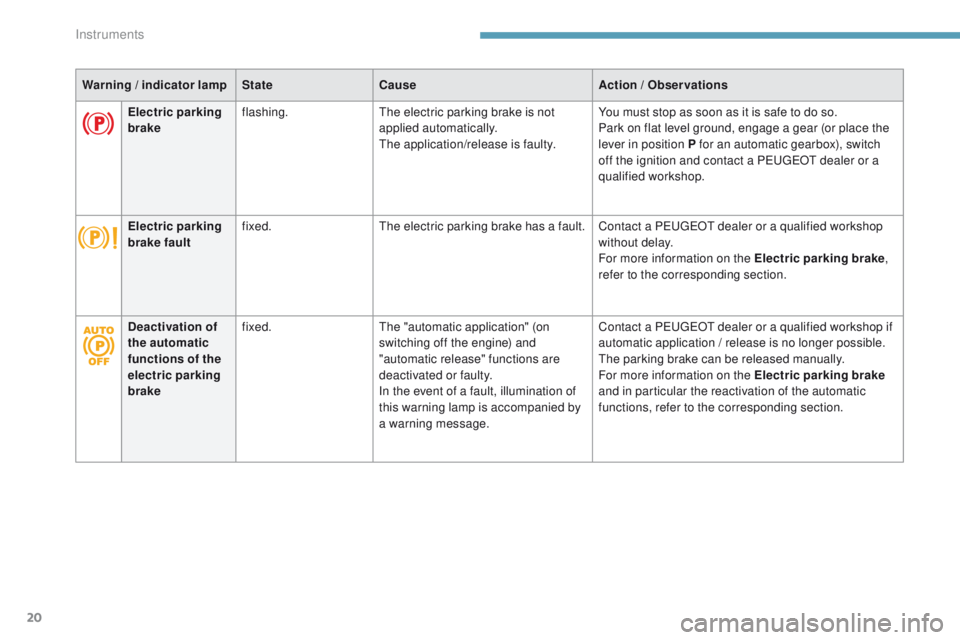
20
Warning / indicator lamp State Cause Action / Observations
Electric parking
brake flashing.
th
e electric parking brake is not
applied automatically.
th
e application/release is faulty.You must stop as soon as it is safe to do so.
Park on flat level ground, engage a gear (or place the
lever in position P for an automatic gearbox), switch
off the ignition and contact a P
e
uge
Ot
dealer or a
qualified workshop.
Electric parking
brake fault fixed.
th
e electric parking brake has a fault. Contact a P
e
uge
Ot
dealer or a qualified workshop
without delay.
For more information on the Electric parking brake ,
refer to the corresponding section.
Deactivation of
the automatic
functions of the
electric parking
brake fixed.
th
e "automatic application" (on
switching off the engine) and
"automatic release" functions are
deactivated or faulty.
In the event of a fault, illumination of
this warning lamp is accompanied by
a warning message. Contact a P
e
uge
Ot
dealer or a qualified workshop if
automatic application / release is no longer possible.
th
e parking brake can be released manually.
For more information on the Electric parking brake
and in particular the reactivation of the automatic
functions, refer to the corresponding section.
Instruments
Page 23 of 392
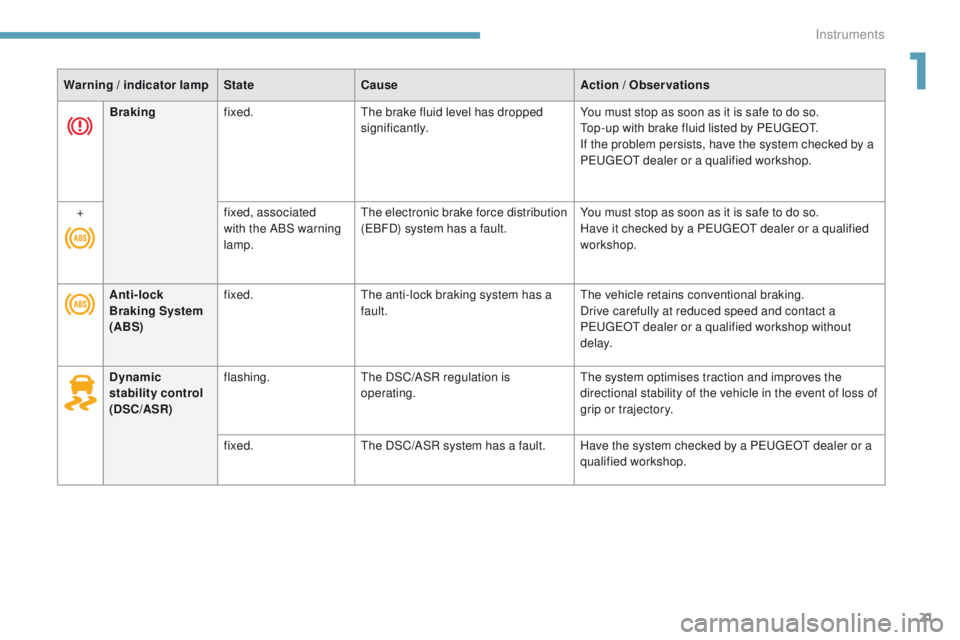
21
Warning / indicator lamp State Cause Action / Observations
Anti-lock
Braking System
(ABS) fixed.
th
e anti-lock braking system has a
fault.
th
e vehicle retains conventional braking.
Drive carefully at reduced speed and contact a
P
e
uge
Ot
dealer or a qualified workshop without
d e l ay.
Dynamic
stability control
(DSC/ASR) flashing.
th
e DSC/ASR regulation is
operating.
th
e system optimises traction and improves the
directional stability of the vehicle in the event of loss of
grip or trajectory.
fixed.
th
e DSC/ASR system has a fault. Have the system checked by a P
e
uge
Ot
dealer or a
qualified workshop.
Braking
fixed.
th
e brake fluid level has dropped
significantly. You must stop as soon as it is safe to do so.
to
p-up with brake fluid listed by P
e
uge
Ot.
I
f the problem persists, have the system checked by a
P
e
uge
Ot
dealer or a qualified workshop.
+ fixed, associated
with the ABS warning
lamp.
th
e electronic brake force distribution
(
eB
FD) system has a fault.You must stop as soon as it is safe to do so.
Have it checked by a P
e
uge
Ot
dealer or a qualified
workshop.
1
Instruments
Page 24 of 392
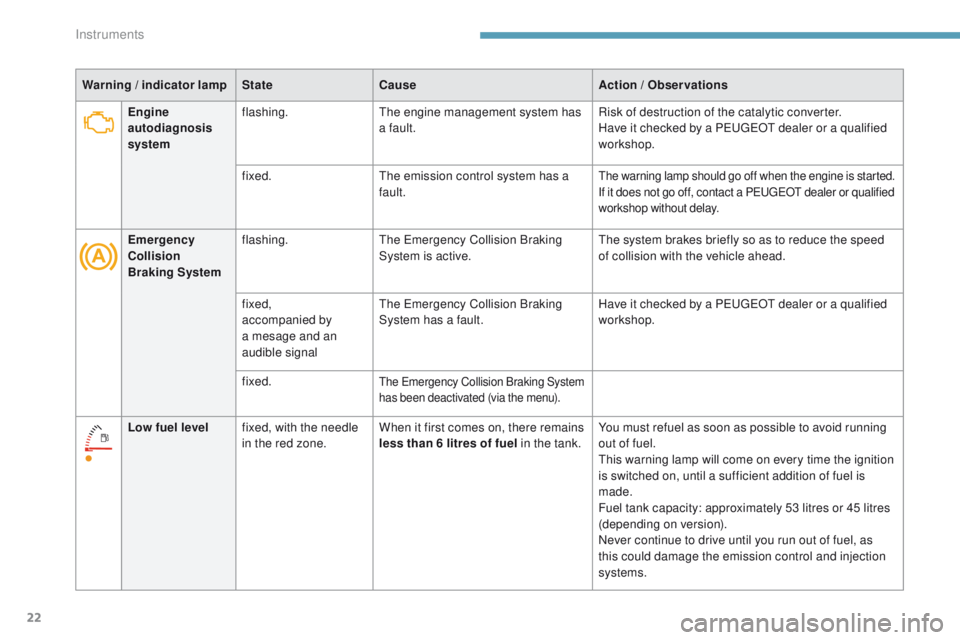
22
Engine
autodiagnosis
systemflashing.the
engine management system has
a fault. Risk of destruction of the catalytic converter.
Have it checked by a Pe
ugeOt dealer or a qualified
workshop.
fixed.
th
e emission control system has a
fault.
the warning lamp should go off when the engine is started.
If it does not go off, contact a Pe ugeOt dealer or qualified
workshop without delay.
Emergency
Collision
Braking System flashing.the
em ergency Collision Braking
System is active.th e system brakes briefly so as to reduce the speed
of collision with the vehicle ahead.
fixed,
accompanied by
a mesage and an
audible signal
the
e
m
ergency Collision Braking
System has a fault. Have it checked by a P
e
uge
Ot
dealer or a qualified
workshop.
fixed.
the emergency Collision Braking System
has been deactivated (via the menu).
Warning / indicator lamp State Cause Action / Observations
Low fuel level fixed, with the needle
in the red zone. When it first comes on, there remains
less than 6 litres of fuel
in the tank.You must refuel as soon as possible to avoid running
out of fuel.
th
is warning lamp will come on every time the ignition
is switched on, until a sufficient addition of fuel is
made.
Fuel tank capacity: approximately 53 litres or 45 litres
(depending on version).
Never continue to drive until you run out of fuel, as
this could damage the emission control and injection
systems.
Instruments
Page 27 of 392
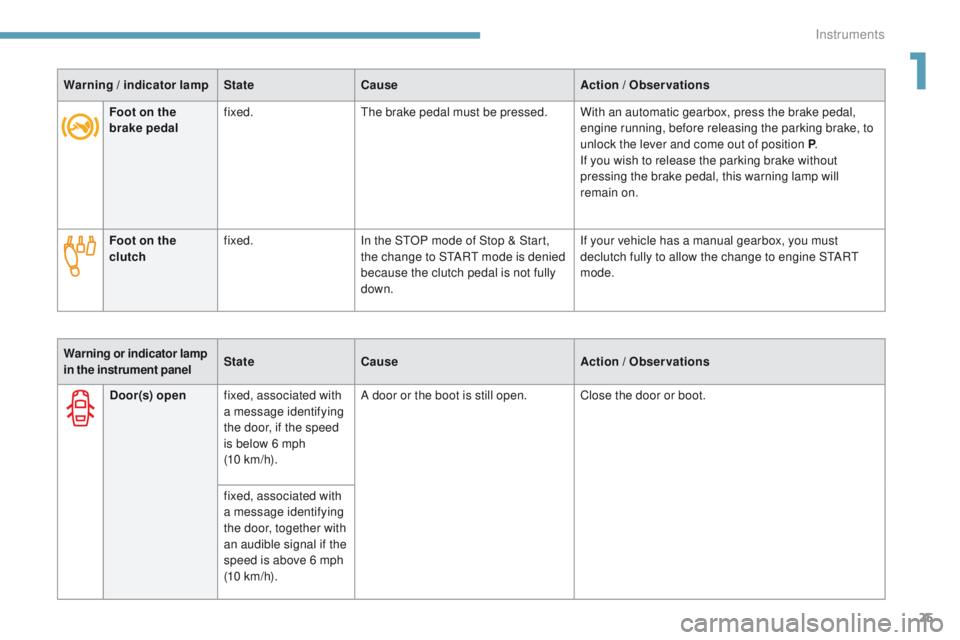
25
Foot on the
brake pedalfixed.th
e brake pedal must be pressed. With an automatic gearbox, press the brake pedal,
engine running, before releasing the parking brake, to
unlock the lever and come out of position P .
If you wish to release the parking brake without
pressing the brake pedal, this warning lamp will
remain on.
Foot on the
clutch fixed.
In the S
tO
P mode of Stop & Start,
the change to S
tA
R
t
mode is denied
because the clutch pedal is not fully
down. If your vehicle has a manual gearbox, you must
declutch fully to allow the change to engine S
tA
R
t
mode.
Warning
/ indicator lamp
State Cause Action
/ Observations
Door(s) open fixed, associated with
a message identifying
the door, if the speed
is below 6 mph
(10
km/h).A door or the boot is still open. Close the door or boot.
fixed, associated with
a message identifying
the door, together with
an audible signal if the
speed is above 6 mph
(10 km/h).
Warning or indicator lamp
in the instrument panel
State
Cause Action / Observations
1
Instruments
Page 123 of 392
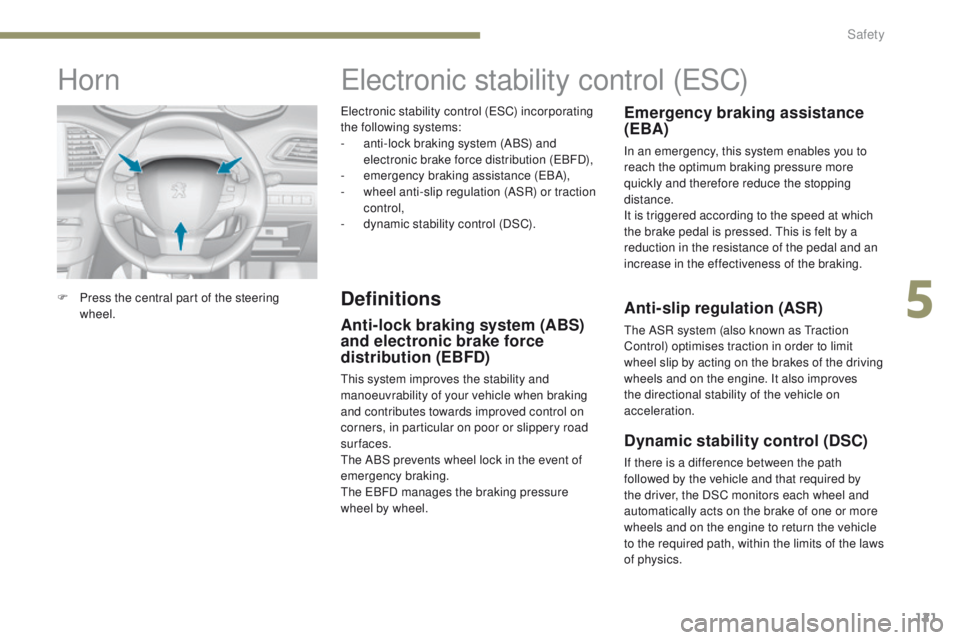
121
electronic stability control (eSC) incorporating
the following systems:
-
a
nti-lock braking system (ABS) and
electronic brake force distribution (
eB
FD),
-
em
ergency braking assistance (
eBA
),
-
w
heel anti-slip regulation (ASR) or traction
control,
-
d
ynamic stability control (DSC).
electronic stability control (eS C)
Definitions
Anti-lock braking system (ABS)
and electronic brake force
distribution (EBFD)
this system improves the stability and
manoeuvrability of your vehicle when braking
and contributes towards improved control on
corners, in particular on poor or slippery road
surfaces.
th
e ABS prevents wheel lock in the event of
emergency braking.
th
e e
B
FD manages the braking pressure
wheel by wheel.
Emergency braking assistance
(EBA)
In an emergency, this system enables you to
reach the optimum braking pressure more
quickly and therefore reduce the stopping
distance.
It is triggered according to the speed at which
the brake pedal is pressed.
t
h
is is felt by a
reduction in the resistance of the pedal and an
increase in the effectiveness of the braking.
Anti-slip regulation (ASR)
the ASR system (also known as tr action
Control) optimises traction in order to limit
wheel slip by acting on the brakes of the driving
wheels and on the engine. It also improves
the directional stability of the vehicle on
acceleration.
Dynamic stability control (DSC)
If there is a difference between the path
followed by the vehicle and that required by
the driver, the DSC monitors each wheel and
automatically acts on the brake of one or more
wheels and on the engine to return the vehicle
to the required path, within the limits of the laws
of physics.
Horn
F Press the central part of the steering wheel.
5
Safety